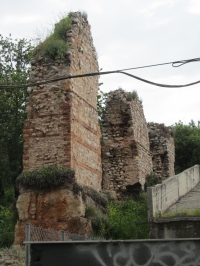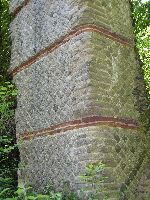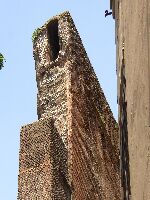


Literature- Vitruvius chapter II.3- L. Lancaster (2008): Concrete and its facings (in: J.P. Oleson: The Oxford handbook of engineering and technology in the classical world pag 260 - 266) - J.P. Adam (1989): La construction Romaine, matériaux et techniques - J.P. Adam (1994): Roman building: materials and techniques |
|
It is indeed quite confusing: Roman concrete, mortar, stucco, plaster and even opus signinum have the same basic ingredients, although their applications are quite different.
These basic elements are an aggregate (or filler), water and a binding agent (sometimes also called mortar). As an aggregate can server gravel, rubble, broken pottery, stones and/or sand. Water is essential but often only small portions are added. Lime, gypsum and/or pozzolana (volcanic material from the present Pozzuoli / ancient Puteoli area near Naples) can serve as a binding agent. Sometimes these mixtures are enriched by special additives. The secret is the quality of the ingredients: the dimensions of the filler(s), the chemical composition of the binding agent(s) and the additives. Preferably local materials were used and that implied a great variety of architectural results. Vitruvius, the noted architect at the end of the 1st c BCE, wrote about it in his well-known treatise De Architectura, chapter II.5 and 6. The simplest form of binding material was lime mortar, a mixture of slaked lime (see separate chapter 6 (Lime)) and sand. When it was available, also gypsum was used. Later on - from the time of August and later - pozzulana was added that interacted with lime resulting in the famous Roman concrete, also called opus caementitium. So this combination of aggregate, water and binding agent was the basis for: - Roman concrete, often applied between walls of stones or bricks - mortar or cement was put between the stones, stone blocks or bricks to strengthen walls (although some structures were built without, see the Pont du Gard (with ashlar blocks) and the Segovia (with chiseled stones) aqueduct bridges) - stucco and plaster for the lining of walls outside or inside, including decorative works - opus signinum, a special water proof (hydraulic) plaster applied in many aqueduct channels. Is consisted of slaked lime, some water, sand an crushed bricks, tiles and pottery. Roman concrete and facingAfter the foundations were set, a framework of two parallel walls of stone or bricks was erected and the concrete was poured out in between them. These walls ware often classified according their facing:- opus incertum was used between the 2nd and early 1st c BCE with a facing of small stones of different size and in an irregular pattern - opus reticulatum was applied between the 1st c BCE and the 2nd c CE with small square-ended stones of similar size in a diagonal pattern, see the 86 km long Gier aqueduct of Lyon. In Frenche these stones are called dents - teeths. - Opus testaceum had a facing of regular placed bricks or tiles,dominant from the mid 1st c CE, see for example Nero's branch of the Aqua Claudia, called the Arcus Caelimontani in Rome. In such larger structures protruding bounding courses of large bricks were applied on specific levels for stability reasons and / or construction purposes. The equivalent of Greek ashlar walls were made in opus quadratum. Opus mixtum consisted of courses of bricks combined with opus reticulatum. Opus Africanum was a combination of dressed blocks and panels of mud bricks or faced concrete. BricksEspecially in the eastern provinces and in Rome before the time of August unbaked sun-dried bricks or mud-bricks were dominant although backed bricks have a long history (4th c BCE, Babylon). The backed bricks of the Romans had serveral main sizes:
Vitruvius (chapter II.3.3) describes other basic forms for (sun-dried) tiles:
During the production process, some brick manufacturers added stamps to their bricks, which could give a nice view into the dating and origin of the bricks. As already has been said: preferably local materials were used during (aqueduct) construction work. Along many aqueducts quarries and lime and brick kilns have been found to provide the basics for the construction of the channel, substructures and bridges. |
| HOME | More literature on more aqueducts | Last modified: April, 2016 - (webmaster) |